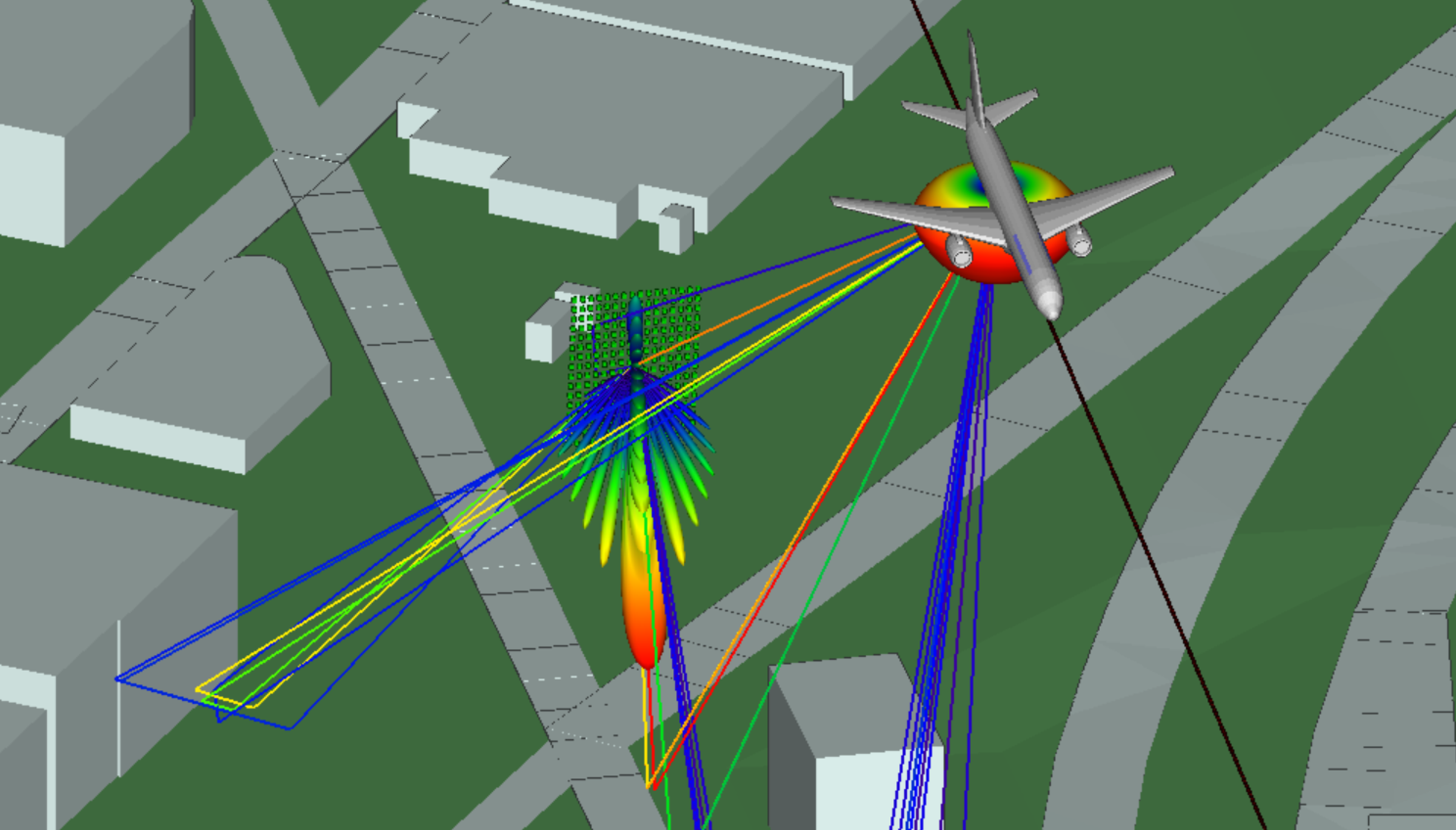In this paper, results are presented of propagation experiments conducted to verify the accuracy of a novel ray-optical scattering model for EES.
A Fast Indoor Coverage Prediction Scheme at 60 GHz Based on Image Processing, Geometrical Optics, and Transport Theory
Optimization of 5G Infrastructure Deployment Through Machine Learning
Assessing 5G Radar Altimeter Interference for Realistic Instrument Landing System Approaches
The safe rollout of new or enhanced 5G services using C-band spectrum near airports in 2022-2023 will require realistic modeling of radio propagation to mitigate potential interference with legacy radar altimeters which remain in operation as of summer 2022. In this whitepaper, we use Wireless InSite to provide a realistic assessment of radar altimeter interference due to emissions from 5G base stations along a landing approach to runway 27L of Chicago O’Hare International Airport.
mmWave Massive MIMO Beamforming in Dynamic, Urban Environments
This Microwave Journal article, which was contributed by Remcom, explores the effectiveness of massive MIMO beamforming at mitigating the challenges expected from using the expanse of spectrum available in the mmWave band. Specifically, it explores a use case involving our Wireless InSite EM propagation software and its mmWave hybrid beamformer capabilities to transmit data streams to a sedan driving in central Manhattan.
Mitigating Wave Scattering – Challenges Facing 5G Wireless Signal Propagation
The following article appeared in the Spring 2020 issue of Focus on Materials, a quarterly bulletin produced by the Pennsylvania State University's Materials Research Institute. Professor Ram Narayanan of Penn State's College of Engineering worked with Remcom to produce a 5G millimeter wave coverage concept using existing AT&T towers in State College, PA, showing ray path predictions generated in Wireless InSite. Here Professor Narayanan discusses the challenges facing 5G signal propagation.
EM Modeling & Providing Narrowband IoT Coverage with Low Earth Orbit Satellites
5G Millimeter Wave Frequencies and Mobile Networks Technology Whitepaper
Using EM Simulation for 5G Design E-Book
Using Modeling and Simulation to Assess Challenges and Solutions for 5G Fixed Wireless Access
One of the planned technologies that may change the digital landscape in the early rollouts of 5G is fixed wireless access (FWA), which will provide new and more flexible wireless solutions for broadband for the last mile to the home. In this paper, we use new modeling and simulation techniques to investigate some of the most critical challenges that FWA faces for operation in the physical environment at millimeter waves.
Simulating Throughput as a Device Design Metric
mmWave Ray-Tracing Simulation with Diffuse Scattering in an Office Environment
Simulation of Beamforming using FD-MIMO for LTE-Advanced Pro in an Urban Small Cell
This presentation demonstrates a new predictive tool for simulating Full Dimension Multiple Input, Multiple Output (FD-MIMO) in urban environments. We evaluate a hypothetical small cell base station employing FD-MIMO for cases using different numbers of transmit antennas, then analyze predicted multipath in the environment and compare performance of beamforming techniques for each of the simulated cases.
Enabling 5G With Massive MIMO
Simulation of Beamforming by Massive MIMO Antennas in Dense Urban Environments
This presentation demonstrates a predictive capability for simulating massive MIMO antennas and beamforming in dense urban propagation environments. Remcom's unique approach allows us to predict the signal-to-interference-plus-noise ratio (SINR) at specific device locations and the actual physical beams formed using these techniques, including unintentional distortions caused by pilot contamination.
Wireless InSite Simulation of MIMO Antennas for 5G Telecommunications
To keep up with rising demand and new technologies, the wireless industry is researching a wide array of solutions for 5G, including Massive MIMO. Remcom’s Wireless InSite provides an efficient method to predict channel characteristics for large-array MIMO antennas in complex multipath environments.
Comparison of Indoor Propagation Modeling of WiFi Coverage Using Wireless InSite and Measurements
This presentation demonstrates how the 3D ray tracing code in Wireless InSite can accurately predict received power coverage even in a multi-room environment containing many walls and different materials types. In order to verify the accuracy of the code, the floor plan of Remcom’s business offices was modeled in the software with a WiFi antenna and a third party tool was used to create a coverage plot of the received power throughout several of the suites.
Empirical / Ray-tracing Hybrid Approach for COST 231 Unknown Building Layouts
Uncertainty in structure geometry is a fundamental limitation of ray-tracing methods when simulating urban propagation. We present a hybrid approach using ray-tracing methods and empirically derived loss factors to incorporate the effect of unknown interior layouts. This approach is compared with a more typical empirical implementation to demonstrate the benefits of hybridization.
High Fidelity Modeling of Spatio-Temporally Dense Multi-Radio Scenarios
Heterogeneous, mobile wireless networks are becoming increasingly difficult to validate for operational use. Presented is an approach to reduce the run-time of these high fidelity simulations by constructing precise results based on adjacent ray-paths from a lower resolution simulation. Speed and accuracy trade-offs are presented for this approach in typical urban scenarios, demonstrating its effectiveness in meeting the growing needs of wireless channel emulation.
Modeling RF Attenuation in a Mine Due to Tunnel Diameter and Shape
Accurately characterizing the propagation of RF signals in tunnels is important for rescue, safety, and military purposes. The material composition of the tunnel, the tunnel shape and size, obstructions, and tunnel bends present challenges. In this paper we use Wireless InSite to analyze how tunnel diameter and shape affect the propagation characteristics.






















